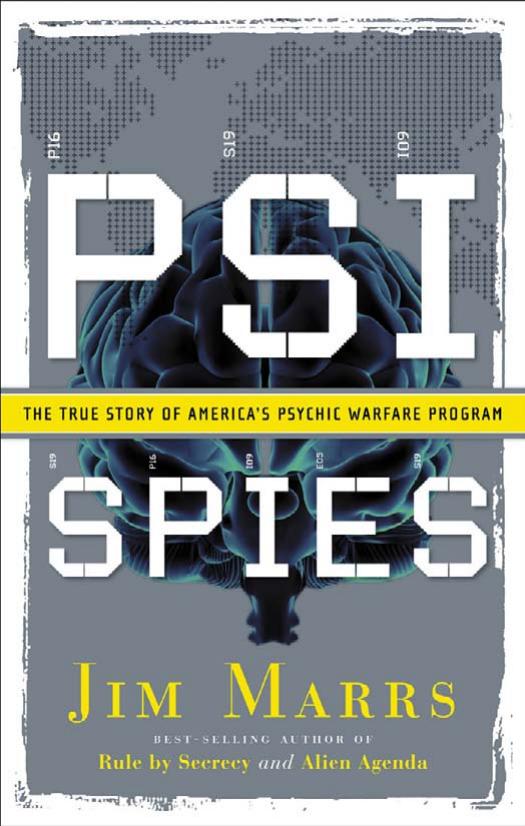PSI Spies: The True Story of America's Psychic Warfare Program by Jim Marrs

Author:Jim Marrs [Marrs, Jim]
Language: deu
Format: epub, pdf
Tags: ISBN-13:, 9781564149602
Published: 2008-02-20T15:10:00+00:00
ESPionage
201
Chapter 7
ESPionage
A perusal of the Psi Spies’ remote viewing targets indicated a wide variety of targets—from a simple look at both well-known and not-so-well-known buildings, to viewing a hostile nation’s chemical warfare plant.
The following sessions were gleaned from the Psi Spies files, which have been retained by several of the unit’s members.
Although targets within the Soviet Union remained the mainstay of the spies’ early operational activities, they were not exclusive. The vast majority of missions were highly classified, with little or no feedback being passed back to the unit, as they had to do with military targets within hostile nations.
Before the Psi Spies were used on serious operations, there were the unremitting tests. 1
201
202
PSI Spies
One practice session in 1989 produced this report, according to Morehouse:
Site is a structure. This structure is moderate in size and is rurally located. The site is frequented by people who spend time observing its contents. The site has many boxes and crates which are aligned uniformly for the purpose of display of their contents. The interior of the structure is both modern and old. There are suspended lights and spotlights throughout the interior.
There are wooden floors and carpeted floors. Other aspects to the site are that there is a large central room, which is suppor ted in purpose by other smaller
rooms. Each of the rooms has cases inside of it. There is a “turnstile” at the site and concepts associated with the word “turnstile” are: tickets, people, theatre, passages, admittance, historic, pay, enjoyment, looking, history, war, music, blades, swords, combat, smoke, and war. Throughout the interior of the site are long objects in large numbers, uniformly positioned. The objects are made of metal and wood—many have
brass or gold-colored metals on them.
Briefly stated, this is obviously a description of a museum dedicated to guns and weapons of war. The site was the J.M.
Davis Arms & Historical Museum in Claremore, Oklahoma.
A promotional piece for the museum stated, “Visitors can walk for a mile through the collection, viewing some relics that date far back, such as a 14th-century, hand-held cannon from the Orient. Along with the guns, the museum also has large collections of antique German steins, Indian artifacts, World War I posters, and a John Rogers statuary, popular during ESPionage
203
the Victorian period.” Many of the guns displayed are decorated with “natural and stained ivory, brass and gold inlays. ”2
In another practice session, Morehouse (the viewer) gave the following description of the Bunker Hill Monument: Site is a structure. The structure is made of stone or concrete. The dimensions of the structure are that it rises sharply from relatively flat sides or base supports....The structure is somewhat central to its surroundings. It is used as a rallying point of sorts (AOL/S like a library, city hall, theater), it is something used or seen regularly....The purpose of the site seems to [be] related to art or remembrance of some past event or person in history. The site is meant to preserve the memory of the event or person. There were perceptions of war, opposing forces in facing lines or ranks.
Download
PSI Spies: The True Story of America's Psychic Warfare Program by Jim Marrs.pdf
This site does not store any files on its server. We only index and link to content provided by other sites. Please contact the content providers to delete copyright contents if any and email us, we'll remove relevant links or contents immediately.
| ESP | Near-Death Experiences |
| Out-of-Body Experiences |
Animal Frequency by Melissa Alvarez(4382)
Sigil Witchery by Laura Tempest Zakroff(4164)
Real Magic by Dean Radin PhD(4063)
Fingerprints of the Gods by Graham Hancock(3926)
Aleister Crowley: The Biography by Tobias Churton(3573)
Journeys Out of the Body by Robert Monroe(3557)
The Rosicrucians by Christopher McIntosh(3455)
Alchemy and Alchemists by C. J. S. Thompson(3435)
Mysteries by Colin Wilson(3384)
Hitler's Monsters by Eric Kurlander(3256)
The Hatha Yoga Pradipika (Translated) by Svatmarama(3206)
John Dee and the Empire of Angels by Jason Louv(3124)
Wicca: a guide for the solitary practitioner by Scott Cunningham(3118)
Infinite Energy Technologies by Finley Eversole(2928)
Book of Life by Deborah Harkness(2855)
Dark Star Rising by Gary Lachman(2816)
The Book of Lies by Aleister Crowley(2789)
Aliens by Jim Al-Khalili(2777)
To Light a Sacred Flame by Silver RavenWolf(2757)
